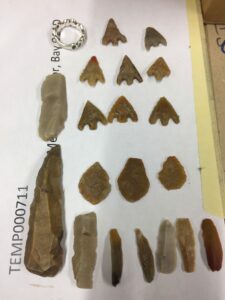
With the help of some generous funding from various research grants (Society of Antiquaries of London, Society of Antiquaries of Scotland, Marc Fitch Fund and Aberdeenshire Council) I have recently embarked on an exciting new project. With the collaboration of lithic specialist Torben Ballin I am going to be looking at the contents of a collection of stone tools that was gathered from fieldwalking alongside the River Dee in the early 1970s.
The stone tools were collected by a local enthusiast, Dr J Grieve, though they were never fully catalogued or published. As far as we know this was the first time that the fields in question had been walked for flints and it will be fascinating to see what the collection holds. It is very rare to get the opportunity to examine an early field collection in detail and I must acknowledge the foresight of the funders in supporting the project.
In subsequent years a small excavation took place on one of the fields resulting in the identification of a significant Mesolithic site (recently published and available here). There were also a few Palaeolithic artefacts, including a fragment of a tanged point (published here), and some Neolithic and Bronze Age pieces. Fieldwalking is still being undertaken here (under the aegis of Mesolithic Deesside): it is an interesting location.
Cataloguing of the new field collections is taking place apace with the help of lithic specialist, Ann Clarke, and they will be published in due course. But we know little about just what it was about the material from these fields that excited Grieve’s attention in the first place. I went down to Aberdeen last week to have a quick look at the boxes of flints (there are several thousand of pieces), and I felt like a child in a sweetie shop. There were bags and bags of goodies. To start with, many of the pieces are big. The lack of flint deposits in Scotland mean that many of the stone tools of the past are much smaller than those to be found elsewhere. So, the large sizes of these pieces surprised me. It may, of course, be illusory. We may find that the assemblages are little bigger than those from recent excavations, but it is a fascinating prospect. Then, there were bags that contained some really beautiful artefacts: arrowheads; finely worked knives; scrapers and cores. It is a real glimpse into a world of archaeology that has, by and large, long since gone. I can’t wait to hear what Torben finds once he has had time to go through them all.
One always wonders how much those who first visit a stone tool site have had the opportunity to remove the best pieces. We don’t really know much about the changes in a frequently collected site over the years. The information we uncover will not just tell us something about the archaeology along the River Dee, it will help us understand lithic scatter sites and the biases in the information that we collect today. It is going to be very helpful in making better sense of this type of site in future. And, given the number of boxes containing old field collections that are currently stored in Scottish (and other) museums, it should help to flag up the research potential of a sadly neglected resource. We tend to focus our attention (and money) on newly identified sites and assemblages. But it is possible that by doing so we are missing some significant finds. I’m sure we are not the only ones to do this, but it does seem like an (almost) unique opportunity to have a rummage around the collections that first inspired the archaeological pioneers of the past.
I’m excited (in case you can’t tell), and I look forward to sharing some of the results as they come up over the following months.
You must be logged in to post a comment.